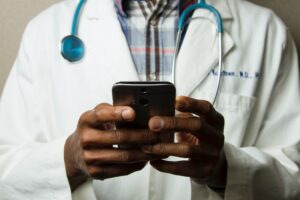It is evident that telehealth is growing, and with it remote patient monitoring (RPM) is emerging as an effective treatment method for acute and chronic conditions.
In previous blogs we have noted how RPM leverages digital tools to record real time health data at one location for a care coordinator or provider to review in another location.
As a means to refresh your memory RPM employs the use of many devices such as weight scales, pulse oximeters, blood glucose meters, blood pressure monitors, and heart monitors.
These enable providers to keep track of patient health metrics between clinic visits and adjust treatment plans as needed, making RPM a beneficial tool for long-term chronic disease management.
Further, the use of RPM has proven to be a viable alternative to in-hospital stays, freeing up much-needed beds and saving the health system a level of financial burden.
Chronic illness affects almost half the Australian population; according to the ABS 2020-21, they were estimated to have one or more conditions. [1]
In this article, we will discuss diabetes, cancer, hypertension and chronic obstructive pulmonary disease, as well as how RPM measures up in the treatment of these diseases.
 DIABETES
DIABETES
A study published in 2019 called Diabetes Management Through Remote Patient Monitoring: The Importance of Patient Activation and Engagement with the Technology demonstrated that RPM could improve diabetic care. [2]
The study showed that those who regularly participated in RPM had lower haemoglobin A1c levels at the end of the program.
Patients living with type 2 diabetes saw improvements in their A1C levels while using remote patient monitoring during the COVID-19 pandemic, another study reports. [3]
In a comprehensive study published in 2022, RPM technology increased glucose data availability for interpretation in women with gestational diabetes. [4]
The use of remote patient monitoring did not appear to improve outcomes; however, it did decrease in-office visits and lower healthcare costs.
The researchers reported that RPM showed modest improvements in glucose control in non-pregnant people with type 2 diabetes.
By implementing telehealth modalities such as RPM, patients with diabetes and providers have the opportunity to communicate more efficiently and gain more access to data while enjoying the convenience of at home care with improved outcomes.

HYPERTENSION
Several studies have found that RPM can help maintain and decrease hypertension or high blood pressure (BP).
One study showed that 81 percent of hypertensive patients who enrolled in a RPM BP monitoring program achieved their goal in seven weeks. [5]
According to the report, a home-based BP control program run by non-physicians can provide efficient, effective, and rapid control, suggesting an innovative approach to managing hypertension.
Another RPM program that combined home BP monitoring with virtual nursing support found that RPM measurements were more reliable and accurate than those taken at clinics. [6]
Based on this clinical evidence, wouldn’t you as a provider incorporate RPM into your hypertension treatment programs?
CANCER
In the US research that RPM can be used to enhance cancer treatments was available long before the Covid-19 pandemic.
In 2016 a study with more than 760 patients receiving routine outpatient chemotherapy were asked to report 12 common symptoms via tablet devices.
Patients received weekly mail prompts as a reminder to report their symptoms. Treating physicians received symptom print outs and nurses received email alerts when patients reported worsening or severe symptoms.
It was found that patients who reported their symptoms electronically had a higher health-related quality of life than those who received outpatient care without remote self-reporting.
Further, patients receiving the intervention were less frequently admitted to the emergency room or hospitalised.
More recently, amid the recent disruptions of the pandemic, RPM has helped ensure continued care for cancer patients in their own homes, including those who contracted COVID-19.
A study published in 2021, reported cancer patients who enrolled in an RPM program and who exhibited positive COVID-19 symptoms agreed it was worthwhile, enabled better management of their symptoms, and made them feel more connected to their care team. [7]
![]()
![]()

CHRONIC OBSTRUCTIVE PULMONARY DISEASE
Chronic obstructive pulmonary disease or COPD is a chronic inflammatory lung disease that causes obstructed airflow from the lungs or breathing problems.
Studies show that RPM can be used to improve care for COPD patients.
A 2021 study revealed that due to the accessibility and increasing accuracy of RPM devices COPD diagnoses and treatment can become more efficient. [8]
Further research indicates that patients feel confident and ready to employ the use of monitoring systems at home. Confirming this another study uncovered that 98 percent of the participants agreed the program was easy to use and said they would be willing to use it throughout the pulmonary rehabilitation period. [9]
With the dissemination of RPM study results, the boundaries of the healthcare system will begin to shift, allowing for more comprehensive chronic care management.
If you would like a demo or to speak directly to the Director of RPM-H please click on the link below.
Contact Form
[1] https://www.aihw.gov.au/reports/australias-health/chronic-conditions-and-multimorbidity
[2] Diabetes Management Through Remote Patient Monitoring: The Importance of Patient Activation and Engagement with the Technology – PubMed (nih.gov)
[3] Remote Patient Monitoring Improves Type 2 Diabetes Outcomes (mhealthintelligence.com)
[4][4] https://pubmed.ncbi.nlm.nih.gov/35809157/#:~:text=Remote%20patient%20monitoring%20in%20non,visits%20and%20lower%20healthcare%20costs.
[5] Development of an entirely remote, non‐physician led hypertension management program – Fisher – 2019 – Clinical Cardiology – Wiley Online Library
[6] Home-Based Remote Patient Monitoring Yields Highly Accurate BP Readings (mhealthintelligence.com)
[7] Oncology Patients’ Perspectives on Remote Patient Monitoring for COVID-19 | JCO Oncology Practice (ascopubs.org)
[8] Early identification and treatment of COPD exacerbation using remote respiratory monitoring – PMC (nih.gov)
[9] People undertaking pulmonary rehabilitation are willing and able to provide accurate data via a remote pulse oximetry system: a multicentre observational study – PubMed (nih.gov)

